2013 MERCEDES-BENZ SLS-CLASS ESP
[x] Cancel search: ESPPage 30 of 286

Warning and indicator lamps
Function Page
:
ESP
® 190
;
Seat belts 187
=
Brakes (USA only)
J
Brakes (Canada only) ?
High-beam headlamps 94
A
Low-beam headlamps 93
B
Turn signal 94
C
SRS 190
D
Check Engine
E
ABS
189 Function Page
F
Engine oil temperature 146
G
Tire pressure 193
H
Electric parking brake (USA
only)
!
Electric parking brake
(Canada only) I
Reserve fuel 192
J
SPORT handling mode 56
K
ESP
®
OFF 5628
Instrument clusterAt a glance
ProCarManuals.com
Page 33 of 286
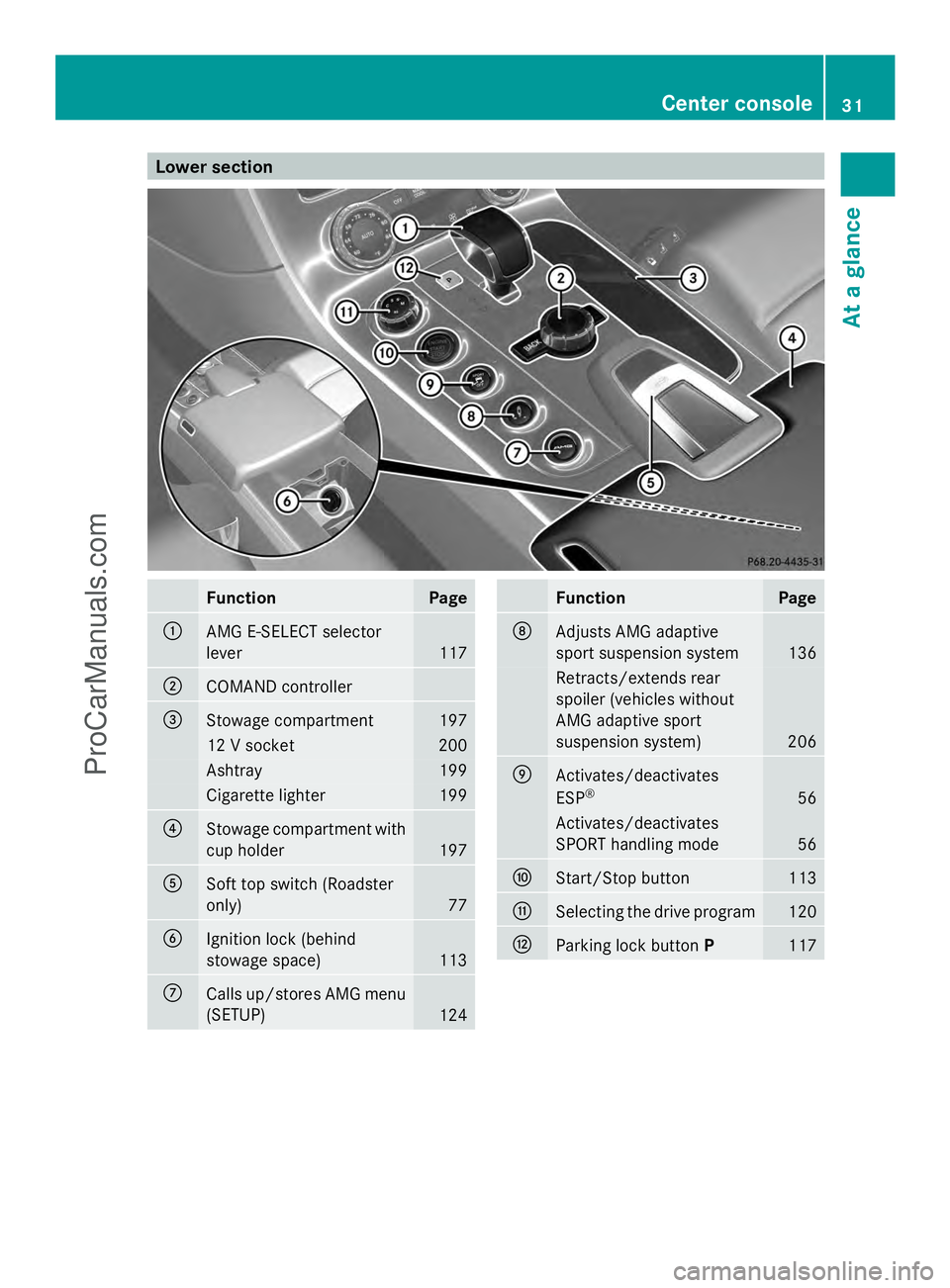
Lower section
Function Page
:
AMG E-SELECT selector
lever
117
;
COMAND controller
=
Stowage compartment 197
12 V socket 200
Ashtray 199
Cigarette lighter 199
?
Stowage compartment with
cup holder 197
A
Soft top switch (Roadster
only)
77
B
Ignition lock (behind
stowage space) 113
C
Calls up/stores AMG menu
(SETUP)
124 Function Page
D
Adjusts AMG adaptive
sport suspension system
136
Retracts/extends rear
spoiler (vehicles without
AMG adaptive sport
suspension system)
206
E
Activates/deactivates
ESP
® 56
Activates/deactivates
SPORT handling mode
56
F
Start/Stop button 113
G
Selecting the drive program 120
H
Parking lock button
P 117Center console
31At a glance
ProCarManuals.com
Page 40 of 286
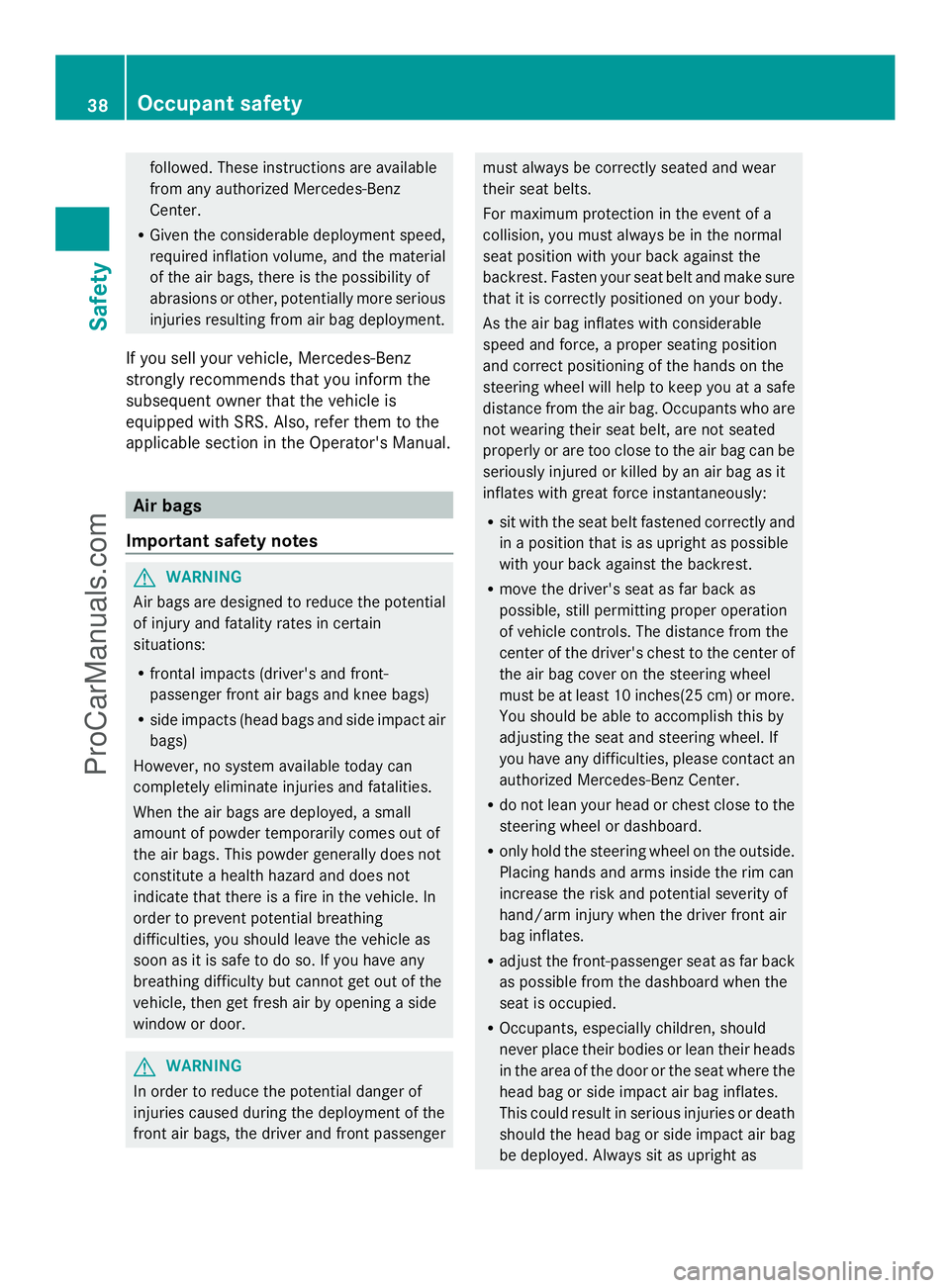
followed. These instructions are available
from any authorized Mercedes-Benz
Center.
R Given the considerable deployment speed,
required inflation volume, and the material
of the air bags, there is the possibility of
abrasions or other, potentially more serious
injuries resulting from air bag deployment.
If you sell your vehicle, Mercedes-Benz
strongly recommends that you inform the
subsequent owner that the vehicle is
equipped with SRS. Also, refer them to the
applicable section in the Operator's Manual. Air bags
Important safety notes G
WARNING
Air bags are designed to reduce the potential
of injury and fatality rates in certain
situations:
R frontal impacts (driver's and front-
passenger front air bags and knee bags)
R side impacts (head bags and side impact air
bags)
However, no system available today can
completely eliminate injuries and fatalities.
When the air bags are deployed, a small
amount of powder temporarily comes out of
the air bags. This powder generally does not
constitute a health hazard and does not
indicate that there is a fire in the vehicle. In
order to prevent potential breathing
difficulties, you should leave the vehicle as
soon as it is safe to do so. If you have any
breathing difficulty but cannot get out of the
vehicle, then get fresh air by opening a side
window or door. G
WARNING
In order to reduce the potential danger of
injuries caused during the deployment of the
front air bags, the driver and front passenger must always be correctly seated and wear
their seat belts.
For maximum protection in the event of a
collision, you must always be in the normal
seat position with your back against the
backrest. Fasten your seat belt and make sure
that it is correctly positioned on your body.
As the air bag inflates with considerable
speed and force, a proper seating position
and correct positioning of the hands on the
steering wheel will help to keep you at a safe
distance from the air bag. Occupants who are
not wearing their seat belt, are not seated
properly or are too close to the air bag can be
seriously injured or killed by an air bag as it
inflates with great force instantaneously:
R
sit with the seat belt fastened correctly and
in a position that is as upright as possible
with your back against the backrest.
R move the driver's seat as far back as
possible, still permitting proper operation
of vehicle controls. The distance from the
center of the driver's chest to the center of
the air bag cover on the steering wheel
must be at least 10 inches(25 cm) or more.
You should be able to accomplish this by
adjusting the seat and steering wheel. If
you have any difficulties, please contact an
authorized Mercedes-Benz Center.
R do not lean your head or chest close to the
steering wheel or dashboard.
R only hold the steering wheel on the outside.
Placing hands and arms inside the rim can
increase the risk and potential severity of
hand/arm injury when the driver front air
bag inflates.
R adjust the front-passenger seat as far back
as possible from the dashboard when the
seat is occupied.
R Occupants, especially children, should
never place their bodies or lean their heads
in the area of the door or the seat where the
head bag or side impact air bag inflates.
This could result in serious injuries or death
should the head bag or side impact air bag
be deployed. Always sit as upright as 38
Occupant safetySafety
ProCarManuals.com
Page 41 of 286
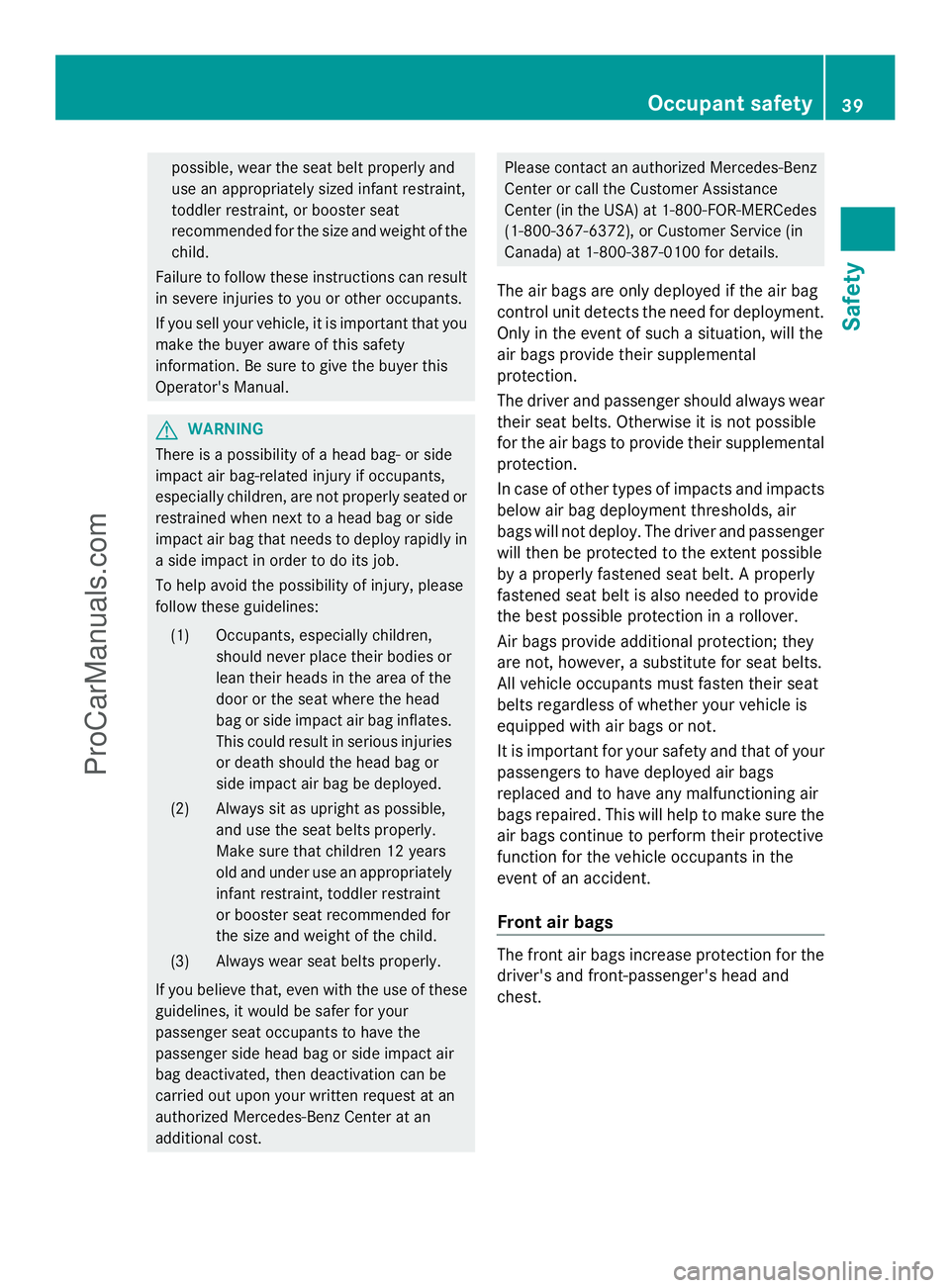
possible, wear the seat belt properly and
use an appropriately sized infant restraint,
toddler restraint, or booster seat
recommended for the size and weight of the
child.
Failure to follow these instructions can result
in severe injuries to you or other occupants.
If you sell your vehicle, it is important that you
make the buyer aware of this safety
information. Be sure to give the buyer this
Operator's Manual. G
WARNING
There is a possibility of a head bag- or side
impact air bag-related injury if occupants,
especially children, are not properly seated or
restrained when next to a head bag or side
impact air bag that needs to deploy rapidly in
a side impact in order to do its job.
To help avoid the possibility of injury, please
follow these guidelines:
(1) Occupants, especially children, should never place their bodies or
lean their heads in the area of the
door or the seat where the head
bag or side impact air bag inflates.
This could result in serious injuries
or death should the head bag or
side impact air bag be deployed.
(2) Always sit as upright as possible, and use the seat belts properly.
Make sure that children 12 years
old and under use an appropriately
infant restraint, toddler restraint
or booster seat recommended for
the size and weight of the child.
(3) Always wear seat belts properly.
If you believe that, even with the use of these
guidelines, it would be safer for your
passenger seat occupants to have the
passenger side head bag or side impact air
bag deactivated, then deactivation can be
carried out upon your written request at an
authorized Mercedes-Benz Center at an
additional cost. Please contact an authorized Mercedes-Benz
Center or call the Customer Assistance
Center (in the USA) at 1-800-FOR-MERCedes
(1-800-367-6372), or Customer Service (in
Canada) at 1-800-387-0100 for details.
The air bags are only deployed if the air bag
control unit detects the need for deployment.
Only in the event of such a situation, will the
air bags provide their supplemental
protection.
The driver and passenger should always wear
their seat belts. Otherwise it is not possible
for the air bags to provide their supplemental
protection.
In case of other types of impacts and impacts
below air bag deployment thresholds, air
bags will not deploy. The driver and passenger
will then be protected to the extent possible
by a properly fastened seat belt. A properly
fastened seat belt is also needed to provide
the best possible protection in a rollover.
Air bags provide additional protection; they
are not, however, a substitute for seat belts.
All vehicle occupants must fasten their seat
belts regardless of whether your vehicle is
equipped with air bags or not.
It is important for your safety and that of your
passengers to have deployed air bags
replaced and to have any malfunctioning air
bags repaired. This will help to make sure the
air bags continue to perform their protective
function for the vehicle occupants in the
event of an accident.
Front air bags The front air bags increase protection for the
driver's and front-passenger's head and
chest. Occupant safety
39Safety Z
ProCarManuals.com
Page 45 of 286
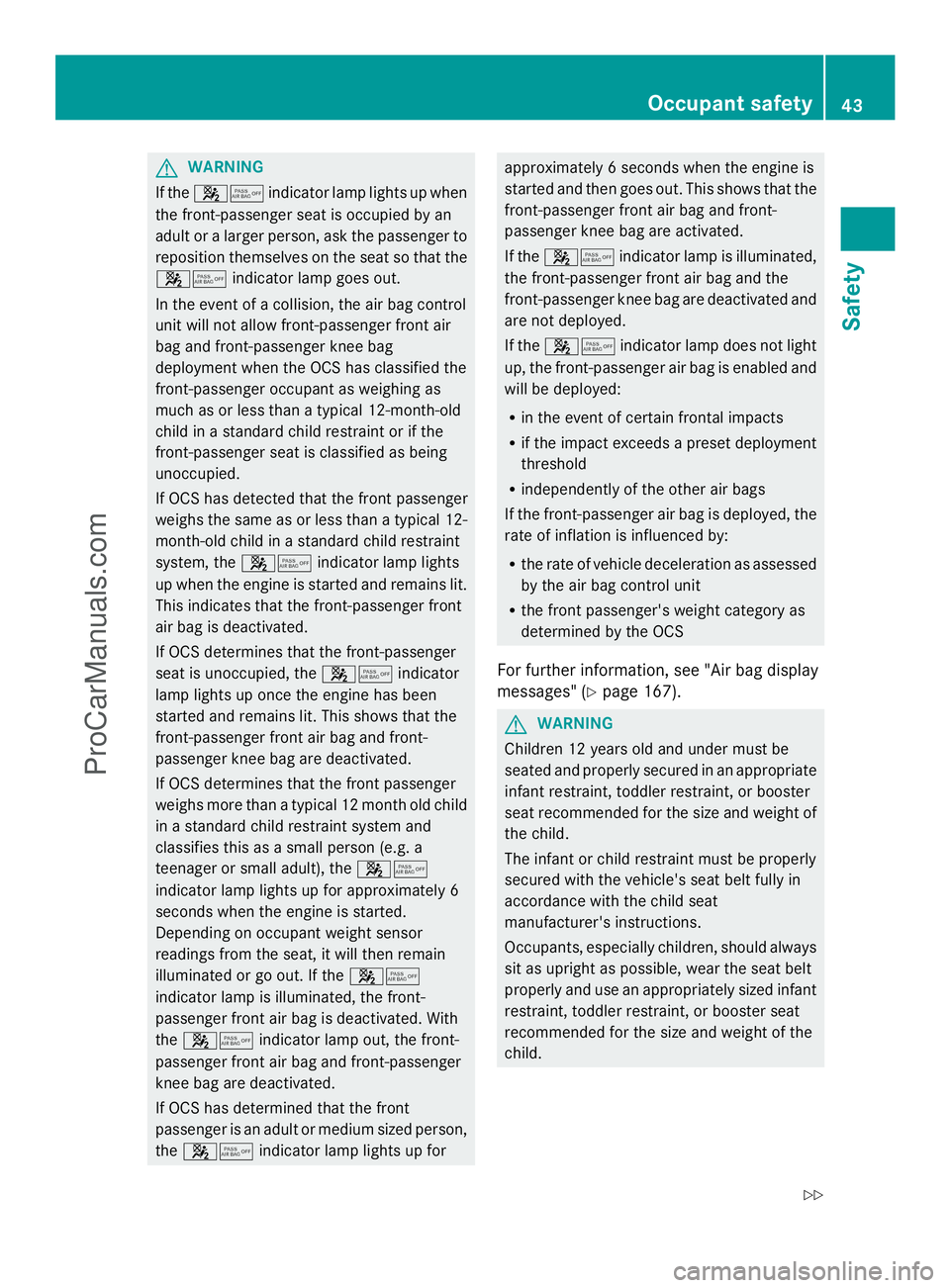
G
WARNING
If the 45 indicator lamp lights up when
the front-passenger seat is occupied by an
adult or a larger person, ask the passenger to
reposition themselves on the seat so that the
45 indicator lamp goes out.
In the event of a collision, the air bag control
unit will not allow front-passenger front air
bag and front-passenger knee bag
deployment when the OCS has classified the
front-passenger occupant as weighing as
much as or less than a typical 12-month-old
child in a standard child restraint or if the
front-passenger seat is classified as being
unoccupied.
If OCS has detected that the front passenger
weighs the same as or less than a typical 12-
month-old child in a standard child restraint
system, the 45indicator lamp lights
up when the engine is started and remains lit.
This indicates that the front-passenger front
air bag is deactivated.
If OCS determines that the front-passenger
seat is unoccupied, the 45indicator
lamp lights up once the engine has been
started and remains lit. This shows that the
front-passenger front air bag and front-
passenger knee bag are deactivated.
If OCS determines that the front passenger
weighs more than a typical 12 month old child
in a standard child restraint system and
classifies this as a small person (e.g. a
teenager or small adult), the 45
indicator lamp lights up for approximately 6
seconds when the engine is started.
Depending on occupant weight sensor
readings from the seat, it will then remain
illuminated or go out. If the 45
indicator lamp is illuminated, the front-
passenger front air bag is deactivated. With
the 45 indicator lamp out, the front-
passenger front air bag and front-passenger
knee bag are deactivated.
If OCS has determined that the front
passenger is an adult or medium sized person,
the 45 indicator lamp lights up for approximately 6 seconds when the engine is
started and then goes out. This shows that the
front-passenger front air bag and front-
passenger knee bag are activated.
If the
45 indicator lamp is illuminated,
the front-passenger front air bag and the
front-passenger knee bag are deactivated and
are not deployed.
If the 45 indicator lamp does not light
up, the front-passenger air bag is enabled and
will be deployed:
R in the event of certain frontal impacts
R if the impact exceeds a preset deployment
threshold
R independently of the other air bags
If the front-passenger air bag is deployed, the
rate of inflation is influenced by:
R the rate of vehicle deceleration as assessed
by the air bag control unit
R the front passenger's weight category as
determined by the OCS
For further information, see "Air bag display
messages" (Y page 167). G
WARNING
Children 12 years old and under must be
seated and properly secured in an appropriate
infant restraint, toddler restraint, or booster
seat recommended for the size and weight of
the child.
The infant or child restraint must be properly
secured with the vehicle's seat belt fully in
accordance with the child seat
manufacturer's instructions.
Occupants, especially children, should always
sit as upright as possible, wear the seat belt
properly and use an appropriately sized infant
restraint, toddler restraint, or booster seat
recommended for the size and weight of the
child. Occupant safety
43Safety
Z
ProCarManuals.com
Page 53 of 286
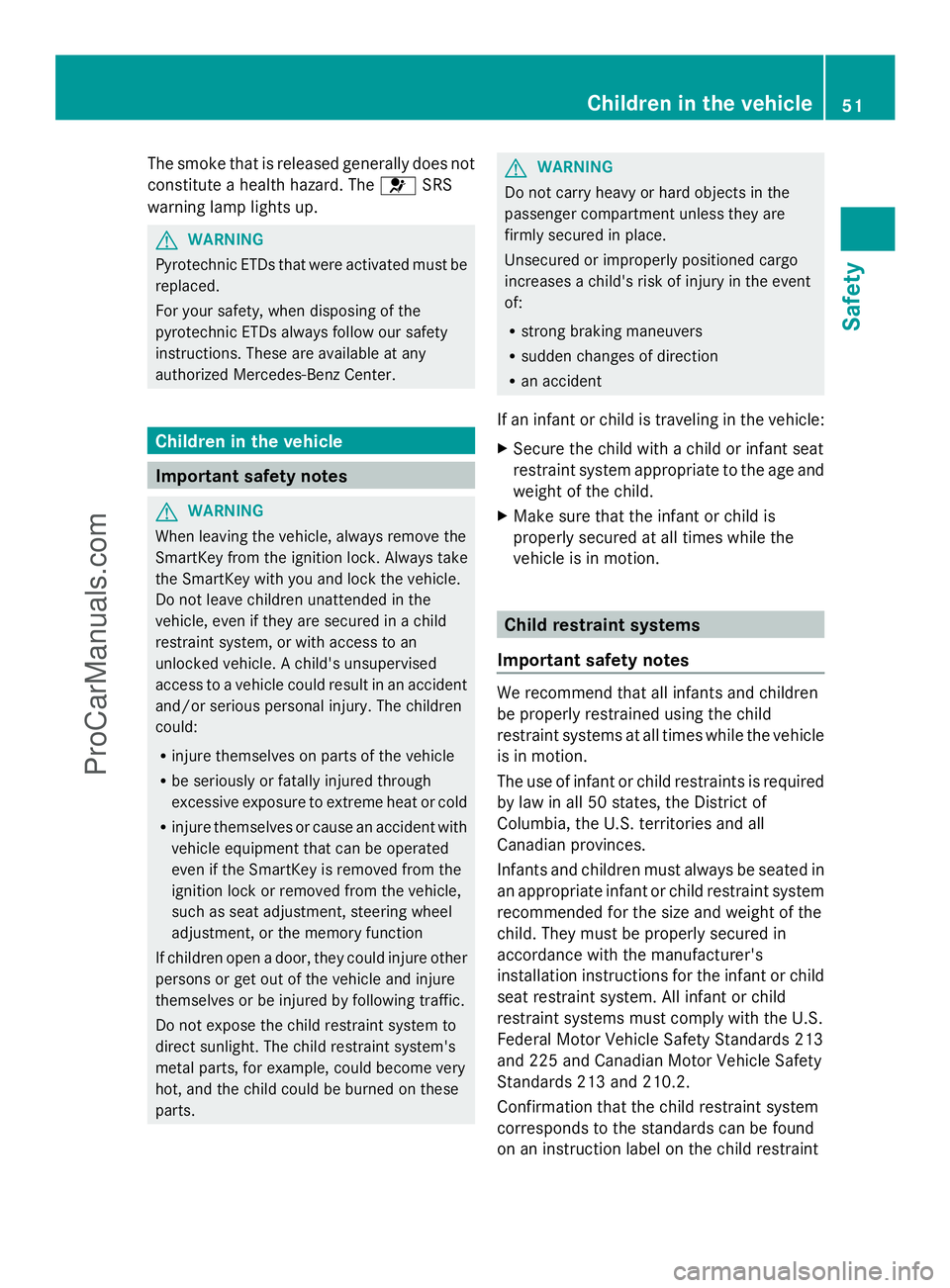
The smoke that is released generally does not
constitute a health hazard. The 6SRS
warning lamp lights up. G
WARNING
Pyrotechnic ETDs that were activated must be
replaced.
For your safety, when disposing of the
pyrotechnic ETDs always follow our safety
instructions. These are available at any
authorized Mercedes-Benz Center. Children in the vehicle
Important safety notes
G
WARNING
When leaving the vehicle, always remove the
SmartKey from the ignition lock. Always take
the SmartKey with you and lock the vehicle.
Do not leave children unattended in the
vehicle, even if they are secured in a child
restraint system, or with access to an
unlocked vehicle. A child's unsupervised
access to a vehicle could result in an accident
and/or serious personal injury. The children
could:
R injure themselves on parts of the vehicle
R be seriously or fatally injured through
excessive exposure to extreme heat or cold
R injure themselves or cause an accident with
vehicle equipment that can be operated
even if the SmartKey is removed from the
ignition lock or removed from the vehicle,
such as seat adjustment, steering wheel
adjustment, or the memory function
If children open a door, they could injure other
persons or get out of the vehicle and injure
themselves or be injured by following traffic.
Do not expose the child restraint system to
direct sunlight. The child restraint system's
metal parts, for example, could become very
hot, and the child could be burned on these
parts. G
WARNING
Do not carry heavy or hard objects in the
passenger compartment unless they are
firmly secured in place.
Unsecured or improperly positioned cargo
increases a child's risk of injury in the event
of:
R strong braking maneuvers
R sudden changes of direction
R an accident
If an infant or child is traveling in the vehicle:
X Secure the child with a child or infant seat
restraint system appropriate to the age and
weight of the child.
X Make sure that the infant or child is
properly secured at all times while the
vehicle is in motion. Child restraint systems
Important safety notes We recommend that all infants and children
be properly restrained using the child
restraint systems at all times while the vehicle
is in motion.
The use of infant or child restraints is required
by law in all 50 states, the District of
Columbia, the U.S. territories and all
Canadian provinces.
Infants and children must always be seated in
an appropriate infant or child restraint system
recommended for the size and weight of the
child. They must be properly secured in
accordance with the manufacturer's
installation instructions for the infant or child
seat restraint system. All infant or child
restraint systems must comply with the U.S.
Federal Motor Vehicle Safety Standards 213
and 225 and Canadian Motor Vehicle Safety
Standards 213 and 210.2.
Confirmation that the child restraint system
corresponds to the standards can be found
on an instruction label on the child restraint Children in the vehicle
51Safety Z
ProCarManuals.com
Page 56 of 286

X
Install the child restraint system.
X Tension Top Tether belt ?. Comply with
the manufacturer's installation
instructions when doing so.
The child restraint system with Top Tether
belt ?has been removed:
X Slide cover :onto Top Tether
anchorage ;. Panic alarm
X
To activate: press!button :for
approximately one second.
An alarm sounds and the exterior lighting
flashes.
X To deactivate: press!button :
again.
or
X Insert the SmartKey into the ignition lock.
or
X Press the Start/Stop button.
The SmartKey must be in the vehicle.
i USA only:
This device complies with Part 15 of the
FCC regulations. Operation is subject to
the following two conditions:
1. This device may not cause harmful
interference, and
2. this device must accept any interference
received, including interference that may
cause undesired operation of the device. Any unauthorized modification to this
device could void the user's authority to
operate the equipment.
The Product label with FCC ID and IC
certification number can be found in the
battery case of the key.
i Canada only:
This device complies with RSS-Gen of
Industry Canada. Operation is subject to
the following two conditions:
1. This device may not cause harmful
interference, and
2. this device must accept any interference
received, including interference that may
cause undesired operation of the device.
Any unauthorized modification to this
device could void the user's authority to
operate the equipment.
The Product label with FCC ID and IC
certification number can be found in the
battery case of the key. Driving safety systems
Overview of driving safety systems
In this section, you will find information about
the following driving safety systems:
R ABS ( Anti-lock BrakingSystem)
R BAS ( Brake Assist System)
R ESP ®
(Electronic StabilityProgram)
R EBD ( electronic brakeforcedistribution)
R ADAPTIVE BRAKE Important safety notes
G
WARNING
The following factors increase the risk of
accidents:
R Excessive speed, especially in turns
R Wet and slippery road surfaces
R Following another vehicle too closely 54
Driving safety systemsSafety
ProCarManuals.com
Page 57 of 286
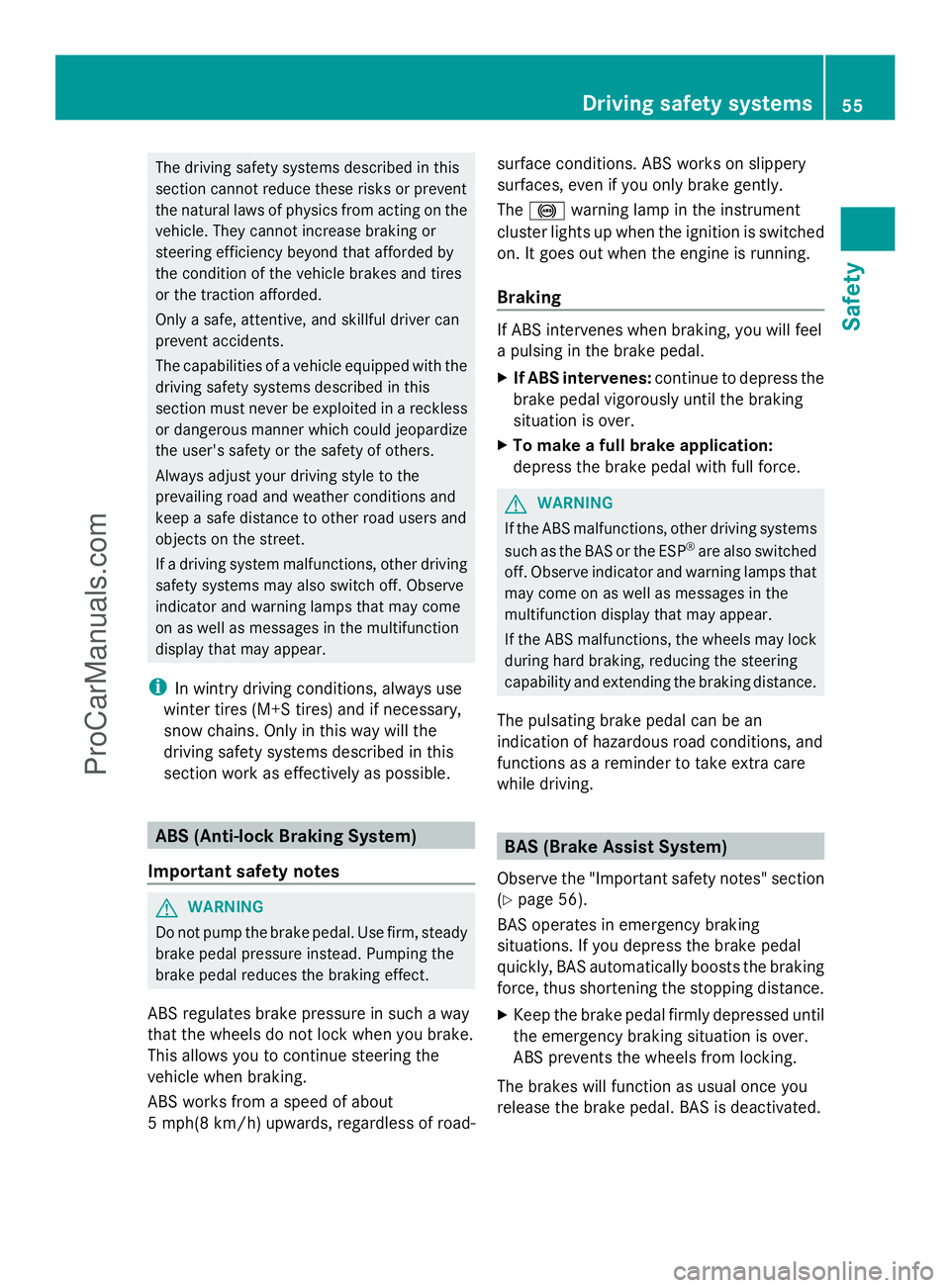
The driving safety systems described in this
section cannot reduce these risks or prevent
the natural laws of physics from acting on the
vehicle. They cannot increase braking or
steering efficiency beyond that afforded by
the condition of the vehicle brakes and tires
or the traction afforded.
Only a safe, attentive, and skillful driver can
prevent accidents.
The capabilities of a vehicle equipped with the
driving safety systems described in this
section must never be exploited in a reckless
or dangerous manner which could jeopardize
the user's safety or the safety of others.
Always adjust your driving style to the
prevailing road and weather conditions and
keep a safe distance to other road users and
objects on the street.
If a driving system malfunctions, other driving
safety systems may also switch off. Observe
indicator and warning lamps that may come
on as well as messages in the multifunction
display that may appear.
i In wintry driving conditions, always use
winter tires (M+S tires) and if necessary,
snow chains. Only in this way will the
driving safety systems described in this
section work as effectively as possible. ABS (Anti-lock Braking System)
Important safety notes G
WARNING
Do not pump the brake pedal. Use firm, steady
brake pedal pressure instead. Pumping the
brake pedal reduces the braking effect.
ABS regulates brake pressure in such a way
that the wheels do not lock when you brake.
This allows you to continue steering the
vehicle when braking.
ABS works from a speed of about
5 mph(8 km/h) upwards, regardless of road- surface conditions. ABS works on slippery
surfaces, even if you only brake gently.
The
! warning lamp in the instrument
cluster lights up when the ignition is switched
on. It goes out when the engine is running.
Braking If ABS intervenes when braking, you will feel
a pulsing in the brake pedal.
X
If ABS intervenes: continue to depress the
brake pedal vigorously until the braking
situation is over.
X To make a full brake application:
depress the brake pedal with full force. G
WARNING
If the ABS malfunctions, other driving systems
such as the BAS or the ESP ®
are also switched
off. Observe indicator and warning lamps that
may come on as well as messages in the
multifunction display that may appear.
If the ABS malfunctions, the wheels may lock
during hard braking, reducing the steering
capability and extending the braking distance.
The pulsating brake pedal can be an
indication of hazardous road conditions, and
functions as a reminder to take extra care
while driving. BAS (Brake Assist System)
Observe the "Important safety notes" section
(Y page 56).
BAS operates in emergency braking
situations. If you depress the brake pedal
quickly, BAS automatically boosts the braking
force, thus shortening the stopping distance.
X Keep the brake pedal firmly depressed until
the emergency braking situation is over.
ABS prevents the wheels from locking.
The brakes will function as usual once you
release the brake pedal. BAS is deactivated. Driving safety systems
55Safety Z
ProCarManuals.com